India Policy Foundation webinar report on "Climate Crisis and Indian Solutions"
Total Views |
India Policy Foundation webinar report on
"Climate Crisis and Indian Solutions"
November 18, 2022
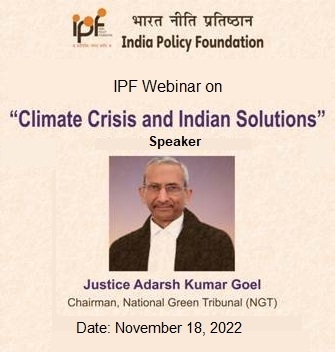
Speaker:
Justice Adarsh Kumar Goel
(Chairman, National Green Tribunal (NGT)
Moderator:
Dr Kuldeep Ratnoo
(Director, India Policy Foundation)
Dr Kuldeep Ratnoo:
I welcome everyone to today’s webinar. We have with us today, Honourable Justice Adarsh Kumar Goel. A number of intellectuals, bureaucrats, academicians, environmental activists etc. have also joined today’s webinar. The topic for today’s discussion is, “Climate Crisis and Indian Solutions.” Justice Goel is someone who needs no introduction but it is important to throw light on his vast experience in law and judiciary.
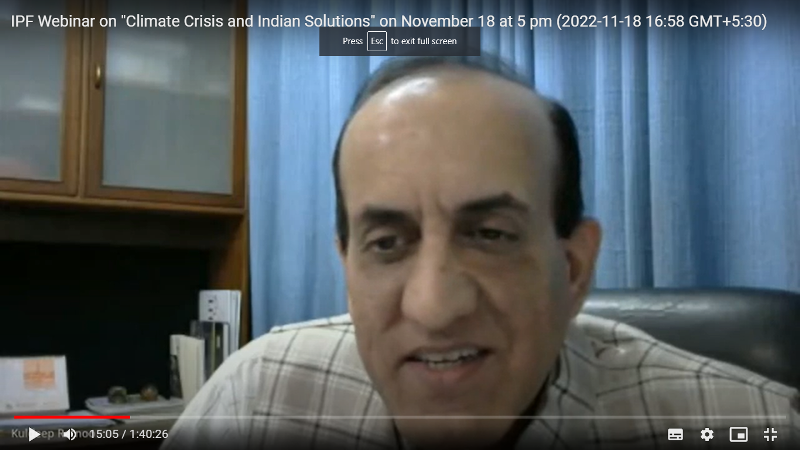
Justice Goel was born in Hisar, Haryana. He did his B.A LLB from Punjab University. After that, he enrolled as an Advocate in the Bar Council of Punjab and Haryana. He practiced there for a few years after which he shifted his practice to Delhi High Court and then Supreme Court. In 1999, he was designated as Senior Advocate by the Supreme Court. In 2001, he was elevated as Judge of the Punjab and Haryana High Court. He was the Acting Chief Justice of the Punjab and Haryana High Court till 2011 and then he joined as the senior most judge of the Gauhati High Court. A few months later, he was sworn in as the Chief Justice of the Gauhati High Court. Later, he was transferred as the Chief Justice of the Orissa High Court. In 2014, he was elevated as the Judge of Supreme Court. In 2018, he was appointed as the Chairperson of National Green Tribunal (NGT). Justice Goel has been instrumental in a number of landmark decisions like installing CCTVs in courts, using technology to resolve matrimonial conflicts, to name a few.
We have been reading a lot about the pro-active stance taken by the NGT headed by Justice Goel to protect environment and people, and how it has been penalising the governments where the latter have failed to act. NGT has a huge responsibility to the protect the environment and it has been doing an exceptional job under him.
Before requesting Justice Goel to address us, I want to make one point here. The Western countries have been exploiting natural resources for their development and now when environmental concerns are rising, these nations are putting the responsibility on countries like India that have just started getting on to the developmental path. Developing countries need to invest in infrastructure, health, education etc. for progress. But developed nations that have already achieved these parameters are putting pressure on developing nations to stall development citing environmental concerns. Developed nations have put almost 80 per cent burden on environment and still want developing nations to address climate change. The rich nations have been evading from their responsibility of actually having contributed so much to environmental degradation. But now climate summits are happening and India has made its stand clear.
Indian solutions have essentially two dimensions, one is the lifestyle changes that we can bring about and the other is how laws can help find solutions. I request Justice Goel to enlighten us on these two aspects.
Justice Adarsh Kumar Goel
Thank you, Dr Kuldeep Ratnoo and to all those who have joined today’s webinar.
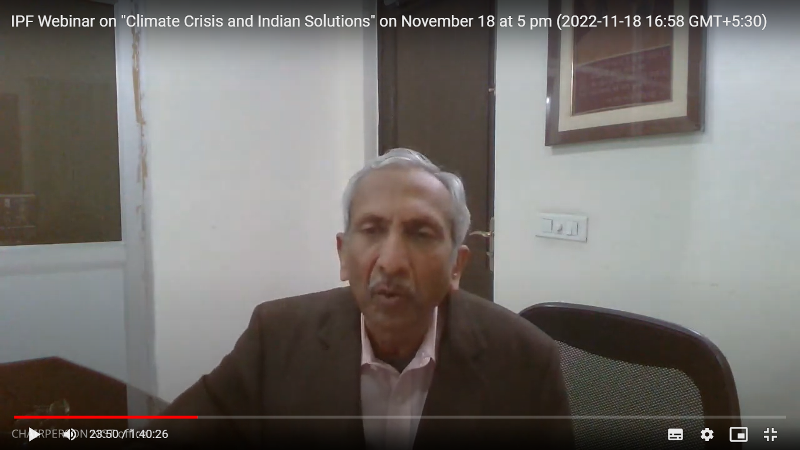
Climate change is an issue that is being discussed widely across the globe. Climate change is not a complicated issue to understand as it is often linked to temperature differences. Global warming is also linked to this. Temperature differs according to geographies. While it may be cold in the hills, coastal areas tend to be warmer. In the 1970s, it was discovered that there was a sudden increase in temperature compared to the pre-industrial era. The temperature may have increased slowly but it was noticed all of a sudden and the scientists of the world got together and flagged that this is an issue that needs immediate attention, otherwise it will have lasting consequences. The scientists had then warned that if the temperature increases by 1.5°C, then it will lead to adverse climatic events throughout the world like melting of glaciers, rising of sea levels, floods, storms, droughts, large-scale displacement of people etc. Human lives will suffer a lot due to this.
To address this issue, major countries got together on 5 June 1972 in Stockholm for the United Nations Conference on the Human Environment. It was agreed that it was a crisis situation and the possible consequences of it are clearly becoming visible. The release of greenhouse gases into the atmosphere were seen as the major reason behind this and it was decided to draft an Action Plan. Carbon dioxide was among the major greenhouse gases emitted and a main source of this was coal. Also known as fossil fuel, coal was used for large-scale industrialisation. An instrument was created to measure air pollution and standards were also defined. There was consensus that the world should aim for sustainable development which essentially means protecting the environment for future generations. It was important to limit the needs of the present generation to secure the future of the planet. Development had to be carried out on a subdued phase.
It has been 50 years since the dangers were identified. Since then, the first step that was taken by nations throughout the world was policy change and legislative framework change. In India, Pollution Board was formed in 1974, the aim of which was to set standards to control air, water and land pollution and to determine the measures to be taken in cases of violation. In 1976, the Indian Constitution was amended to add Article 48 A which said that the state shall endeavour to protect and improve the environment and to safeguard the forests and wildlife of the country. In Article 51a(g), it was stated that the citizens are also responsible for the protection of the environment. This was done through the 42nd Constitution amendment.
After 1972, numerous treaties were signed at the international level on environment cooperation. In 1988, the Intergovernmental Panel on Climate Change (IPCC) was established by the World Meteorological Organization (WMO) and the United Nations Environment Programme (UNEP). Since we have limitations of time, it is not possible to mention all the developments that have taken place since then.
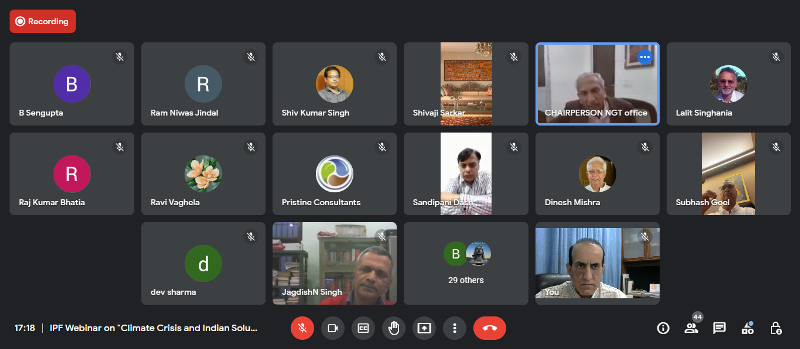
In 1984, Bhopal gas tragedy happened in India which killed more than 4000 people in an instant. It had adverse effects on the health of 5.5 lakh people and remains one of the biggest tragedies of the world. To take a relook at the global issues, Rio conference was held in 1992. When the nations were taking stock of the developments of the last 20 years, it was found that the situation had worsened. So, it was decided that each nation will contribute a sum annually towards achieving the sustainable development goals. There were also debates on drafting a legal framework at the global level for fighting climate change. In 1995, the United Nations Framework on Climate Change was formulated. According to this, the 196 nations who were parties to the 1992 agreement will meet every year and discuss the Action Plan that each nation has framed to fight climate change. This was expected to take into consideration unique issues faced by each nation state.
In 1997 Kyoto Protocol, the target of each country was defined and it was later replaced by the Paris Agreement of 2015. In it, it was found that many nations are victims of climate change and their contribution to global warming is less. Take the case of India which is seriously affected by climate change; it has 12 states in coastal areas, has a vast coastal line and also a huge population. To fulfil the needs of the growing population, India has coal reserves. Coal is the single biggest source of energy in the country and even now, the nation will be plunged in darkness if there is no coal. The alternative sources of energy like solar energy, wind energy, hydro energy, nuclear energy can prove to be expensive in the initial stages. So, it was decided that the advanced countries will contribute a sum of USD 100 billion per year towards developing countries so that they can adopt cleaner sources of energy. This came to be known as climate finance. The developed countries strengthened their manufacturing sectors and the economy by primarily relying on polluting activities and now when they have agreed to reduce their pollution levels, they have in fact reached a stage where they can afford to do it. They have also outsourced their manufacturing to countries like India and China which are still dependent on coal.
According to the data compiled by IPCC, the total contribution of India towards global pollution is four per cent whereas the contribution of the United States of America is 25 per cent. A fact that needs to be noted here is that this is despite India having one of the largest populations of the world. However, India is highly vulnerable. So, in 2017, the Government of India formulated a National Action Plan for Climate Change (NAPCC) under which there are eight missions - National Solar Mission, National Mission for Enhanced Energy Efficiency, National Mission on Sustainable Habitat, National Water Mission, National Mission for Sustaining the Himalayan Ecosystem, National Mission for a Green India, National Mission for Sustainable Agriculture and National Mission on Strategic Knowledge for Climate Change. These are defined missions and on the basis of this, there are also state missions. This is an attempt to promote clean energy sources with the eventual goal being phasing out fossil fuels, for transportation as well as for domestic uses.
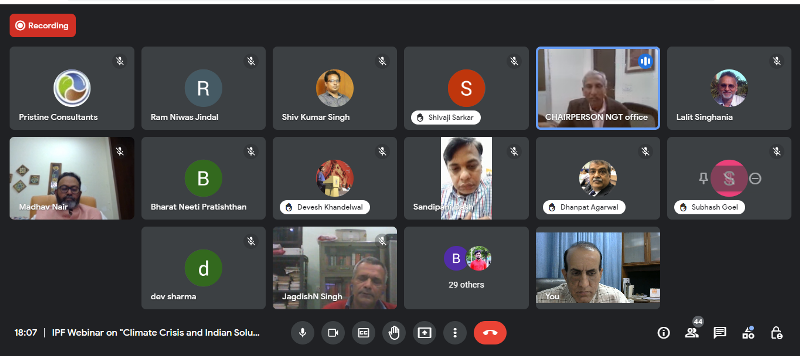
In last year’s CoP 26 Glasgow summit, Prime Minister Narendra Modi declared a five-fold strategy — termed as the panchamrita to fight climate change. Among the goals, he stated that India will be carbon neutral by 2070. He said we need 50 years to replace coal as our primary source of energy. The second goal mentioned was that India will expand its non-fossil energy capacity to 500 gigawatts (GW) by 2030. The third goal is to reduce the carbon intensity of the economy by less than 45 per cent. The fourth goal is to meet 50 per cent of India’s energy requirements from renewable energy by 2030 and fifth to reduce the total projected carbon emissions by one billion tonnes from now onwards till 2030. But there are also certain conditions that India has put forth to achieve this mission. The first is that developed nations should give India climate finance, India will transition towards green hydrogen and will tap into different sources that can replace coal etc.
However, the adverse effects of climate change won’t wait till we slow down our carbon emissions. We need to ponder over where will the world be in 50 years and what will our future be. We are currently saying that we will halve our dependence on fossil fuels by 2030. But what about the next eight years? We don’t have any easy answers. The world will definitely be affected by global warming. But we need to focus on India. If you look at the latest findings of IPCC, in the last 50 years, the temperature has already risen by 1.1°C. Earlier, our target was to ensure that the temperature doesn’t rise by 1.5°C and right now, there is no guarantee that there won’t be any further increase in the temperature in the next 50 years. Secondly, the effects of climate change are being felt by everyone now.
It is true that coal is the biggest source of energy for India and there may not be immediate solutions to replace it. Let us accept that. It is something that we may not have the power to change. But all across the county, garbage is a big concern. In Delhi itself, there is around 3 crore tonne waste that we often term as legacy waste or accumulated waste. There are huge mountains of garbage in places like Ghazipur and Okhla. According to the existing rules in India, the total amount of waste generated on a particular day will have to go for remediation and processing that day itself. There are mainly two kinds of waste – biodegradable and non-biodegradable. The kitchen waste comes under biodegradable and is very easy to process and turn it into manure. But if it is not processed on the same day, it can become very dangerous. It can become the source of multiple diseases and can also contaminate groundwater. It is very easy to establish fertiliser centres in every nook and corner of the country. But we have not done it so far and have not even started a debate on the issue.
The second is non-biodegradable waste. It includes plastics, metals, construction waste etc. which do not have any immediate consequences if they are not processed. The rules stipulate that the wet waste has to be converted to compost which can replace chemical compost and dry waste will have to be converted to energy or recycled. The first step is separation or segregation of garbage at source which is not happening in the country. Either homes do not keep two bins or if they do, those who come to collect the garbage end up mixing the two bags. There are exceptions but this is a major concern across the country which has resulted in tonnes of waste.
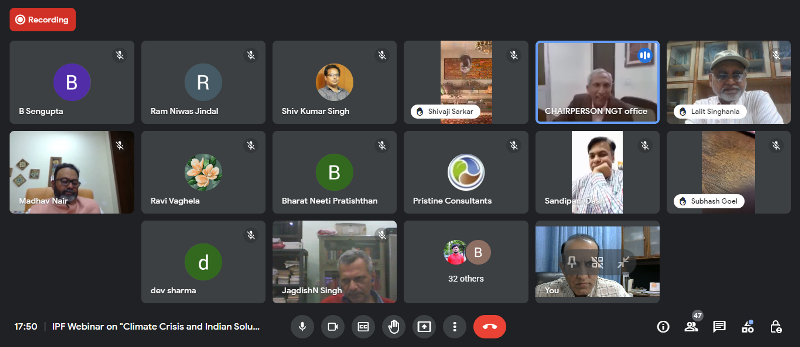
Earlier, I gave the example of Delhi which has around 3 crore tonne waste lying in vast stretches of land. If we look at the circle rate of land underneath this garbage, it will be around Rs 10,500 crore and to clear this land it will cost around Rs 1000 crore. The question is, who will execute this? The government machinery is unable to do so. This topic is very much connected to global warning as the gases emanating from garbage is thirty times more toxic than carbon dioxide and affects climate change in an adverse manner.
The second issue I would like to focus on is the sewage that is generated from houses. In the earlier system, the greywater and sewage sludge were handled separately. Sewage sludge used to be converted to manure and the greywater would meet with a water source and its remediation used to take place. But in the current system that we have put in place aping the West, sewage sludge and greywater are getting mixed. Due to this, the bacteria present in sewage sludge gets multiplied and we are connecting this to the rivers. This is the reason why rivers like Ganga and Yamuna no longer remain sacred. We have contaminated the water because of which living beings are facing a drinking water crisis. It is affecting biodiversity and wildlife.
In 2014, projects like Swachh Bharat and Namami Gange were launched for which the government of India had allocated huge funds. But the state governments were only interested in spending the money without understanding its real need. So, the core problem was never solved because of which we still have mountains of garbage in a city like Delhi. In Ghazipur, the garbage mountain stands 65 feet tall, just 8 feet less than Qutub Minar which is 73 feet tall. Yamuna is filled with sewage and toxic foam. This has happened due to lack of efficient management. If we treat sewage and convert it into manure, it is profitable. The net value is greater than cost of processing of sewage. After treatment, greywater can be used in agriculture to increase the fertility of land. It will also stop river water from getting contaminated. The government of India has distributed Rs 1.44 lakh crore to states just last week for this very purpose. Despite having resources and machinery, India is still lagging in addressing this issue.
People often ask why NGT imposes hefty fines like Rs 2000-3000 crores on state governments. It is because the responsibility lies with the state government to ensure that the funds are properly allocated and all the environmental concerns are addressed. From the British era, the administration of the states function in such a way that people are not taken on board. The compensation that we impose is for the 2 crore per million litre water per day that flows into the rivers without treatment and for garbage it is Rs 300 per metre. This is the accountability of the states. Contrary to the popular view, the amount is not the result of any baseless calculations and it is in fact deposited with the state governments. It is done so that this money is not spent on anything else.
Now, I will come to the Indian solutions. There are a number of models around the world. All the western policies are based on materialism. They consider human beings as just bodies and they only address the material aspects of life. Whereas in Indian thought, there is a belief that a human being is not just a body. A human being has emotions, intelligence and soul and it is necessary to consider all these aspects. This is the major contribution of Indian thought which also makes it distinct from the West. We believe that unless spiritual development takes place, we as a nation cannot develop. In materialism, people are only concerned about their lives and they don’t care what happens to others. In spiritualism, we want the world to be happy and we find happiness in that. This approach is missing in our administration. If India has to show the path to the world, then we have to talk about how spiritualism can help this cause. Our mission should be to do what is best for humanity. Only if we have a mission to serve people can we find solutions to such big problems. We look to nature with this emotion.
In the western world, the prevailing view is that nature should be conquered, nature should be exploited etc. In Indian culture, nature was always seen in the form of father, mother or god. We used to understand the power of nature. During the time of Covid, at least to some extent people have started understanding this power of nature. If we exploit nature, nature is sure to seek revenge. We cannot conquer nature. We have to co-habit with nature. We have to exist along with forests and rivers. If we start cutting down trees to build big mansions, we will not be able to live peacefully. Even wildlife plays an important role. The scientific management of life and right approach are equally important. I have flagged some important issues and we can take this discussion forward in the Q&A session.
Dr Kuldeep Ratnoo:
Thank you so much Justice Goel for throwing light on the issues and concerns regarding climate change at the global level and also with reference to India. As you pointed out, the problem of garbage is huge in the country. You have also mentioned the Indian solutions to climate change. We will come back again to these topics in the Q&A session.
Q&A session
Priyadarshi Datta: It may be remembered that only two prime ministers of the world participated at the UN Conference on Environment at Stockholm, 1972. The first was Swedish PM Olof Palme because he was the host. The other was Indira Gandhi, the then PM of India. This proves that India has been well aware of the threats to environment and has been working towards mitigation even though its contribution to environmental deterioration has been less.
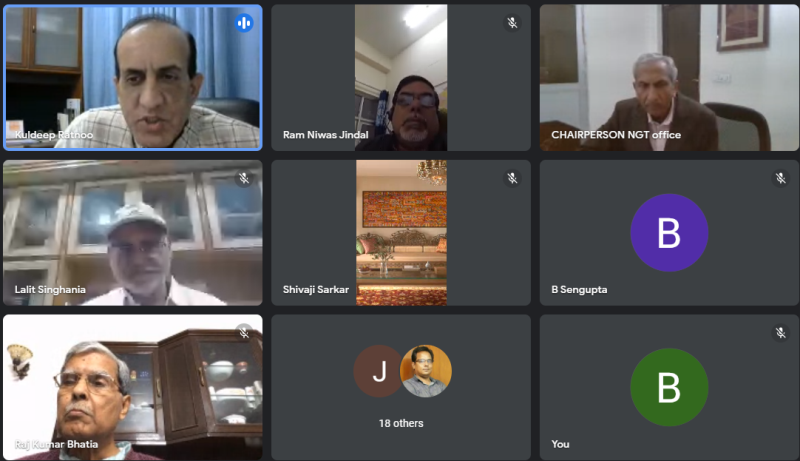
Shivaji Sarkar: NGT is ignoring the problems of the people. In the West, trimming of trees is an art. But in India, the police get involved in the process and even stall it. The second issue is scrapping of cars which has been allowed in India which itself is a polluting act. It also leads to making more cars which further increases the carbon footprints. What is your take on this?
Justice Goel: In 1972, the speech made by the Indian prime minister clearly mentions what India’s thoughts are on the environmental protection. She had also mentioned how in Atharva Veda there is the concept of sustainable development which states that if we take something from the nature, we need to give back in equal measure in order to maintain the natural balance. Before that, her father Jawaharlal Nehru when he was the PM said in 1955 that the Himalayas can be worshipped, scaled but can never be conquered. This statement was also included by Indira Gandhi in her speech. It is true that the world did not take the environmental concerns seriously at the political level during that time.
Coming to the second question, it is true that many vehicles are being manufactured in the country. We do not have any control over the FDI policy regarding the manufacturing of vehicles in India. We are manufacturing more vehicles than what is needed. The most important point is to determine the limitations of human activities. Take the case of Delhi for example, what is the optimum number of vehicles that can ply on the roads? Unfortunately, there is no mechanism to keep a count of it or any policies to cap the manufacturing capacity. Diesel vehicles that are more than 10 years old and petrol vehicles that are more than 15 years old have already been banned by the orders of the Supreme Court. Euro VI norms are in place. NGT also has to go by the orders of the Supreme Court.
It is not necessary to scarp the vehicles. You can take it outside NCR. This particular condition was imposed because the air quality index of NCR does not permit any activities that can worsen the pollution levels. The second option which is also part of the scrapping policy is for the manufacturers to buy the old vehicles and refurbish them. But in cases where scrapping is the only option, we need to ensure that it is done in a scientific way and as many parts are reused as it is possible. But since this is covered by the orders of the Supreme Court, NGT has no discretion as such on this.
Lalit Singhania: Is it possible to address the issue of carbon footprints without taking into account the rising population? Is it not necessary to teach the impact of population explosion on environment in schools and colleges?
Justice Goel: It is important to control population growth. But more important is our urban development planning which can ensure that density of population is not concentrated at one place, people do not have to commute long distances and they have accommodations available near their places of work. This requires serious application of mind and calls for a major policy shift. In this, some people may be adversely affected or offended and it needs to be seen how far populist governments can go to achieve this goal. More than population control, population planning and habitation planning is required.
Ram Nivas Jindal: There is a school of thought which says that adverse climatic incidents are due to shifting of climate.
Justice Goel: There are a number of theories in science. But global warming remains a fact and the main reasons for this are the industrial activities, burning of fossil fuels and combustions and also greenhouse gases. Today, many buildings are termed as green buildings but most of them do not have any circulation of air inside, lights are on all the time and the ACs are on even when it is not required. In cars, air conditioning is compulsory due to the poor quality of air outside. This also generates greenhouse gases. We need a comprehensive policy framework to ensure that all the buildings are properly ventilated and the AC usage is kept to a minimum. If we increase the dependence on fresh light and fresh air, it can be a major power saving program.
Ram Nivas Jindal: The concept of environmental compensation appears to be a wonderful idea. Is it not taking money from one pocket to another while criminal justice system as envisaged in environmental laws has been undermined?
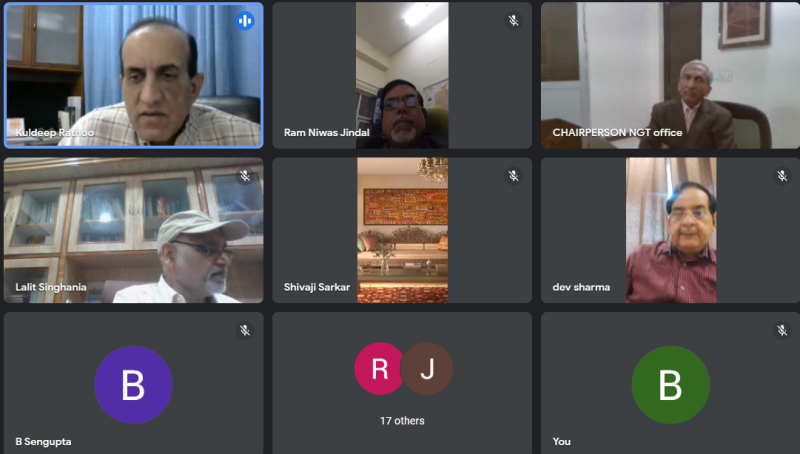
Justice Goel: This is an issue that requires wider debate but I shall try and explain it in a few words. If the private players of industry discharge the pollutants in water bodies or in atmosphere, our criminal justice system remains paralysed because it is time consuming and the state’s machinery is not competent to establish the standard of proof. Very few people have been convicted so far despite the country having legislations like the Water Act, Air Act etc. in place. In the “polluter pays principle,” that standard of proof is not required. Stern action is taken immediately in cases of violation and if they do not pay the fine, their electricity is cut and it is effectively enforced. And this never goes from one pocket to the other. From a private player, this money comes to the government and public. It also gets difficult for these companies to get funding and loans from banks as it is clear that they are not environmentally compliant and it raises questions on their credibility. Second, it is almost impossible for government to prosecute these players by fixing responsibility. You said that money goes from one pocket to another. But even in that process, there is clear cut fixing of responsibility. All the officers are made answerable. In recent years, when we started imposing compensation on states, the process has become even more stringent as now even the highest-ranking officers are made accountable. They even have difficulty in getting promotions if the rulings are not properly enforced. It is interesting to note that state governments are taking funds from the World Bank as well as the central government to implement environmental policies yet they don’t do anything. Now when we are pointing out that these state governments have not done anything in the last 50 years, then it becomes difficult for them to get funds from the World Bank and also the central government.
S.K. Jain: The thin line between environment and nature will have to be erased.
Sanchita Jindal: NGT had imposed crores of rupees of environmental compensation on states for waste management. Has any state deposited the amount? What is their reaction?
Justice Goel: Yes, most of the states have deposited the compensation and that amount is with the states itself. It is in a way allocation of funds earmarked only for that purpose. It is put in an account under the chief secretary of that state to be used only for that purpose coupled with the finding that you are a violator and you have caused loss to the environment to this extent.
Ram Nivas Jindal: Vehicle scrap policy is not a consumer-friendly policy, it benefits the companies.
Justice Goel: Vehicle scrap policy is a policy of the government and there is no room for any judgement.
Madhav Nair: How would West compensate the developing countries as the former caused the maximum damage? They have also not fulfilled their monetary support for the transition. Should we introduce carbon pricing and carbon taxing?
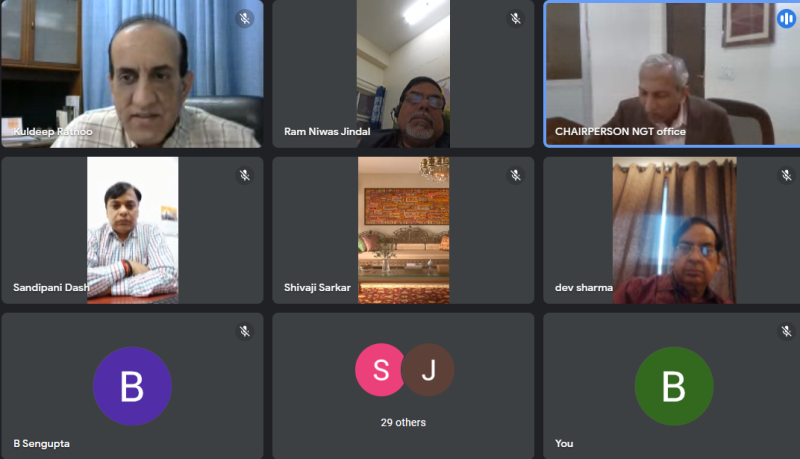
Justice Goel: It is true that the promise of the western nations to give USD 100 billion per year is only on paper. Till the time the West doesn’t voluntary come forward to fulfil this obligation, international commitments are not easy to be enforced. It remains a question whether it will ever happen. The issue of climate finance is often raised in response to them generating greenhouse gases. They are in a position to give that fund and it is actually required to make the shift to clean energy sources. But for that to happen, it is important for them to realise that the whole world including them will be destroyed as a result of climate change. Developing nations do not have the resources to invest in technology and they will continue being dependent on coal for energy needs.
In Delhi, gradual action plan was formulated by the government to address the issue of AQI going past the 500 mark. NGT has also ordered that there will not be any pollution load, otherwise it will result in large-scale deaths. Number of people will be affected by lung damage. How is this going to affect world climate change and what will be the long-term consequences are areas of concern but what is more important are the immediate effects. We have to put an end to activities that contribute to air pollution. Children and the elderly are most affected when the AQI touches 300 which is near critical. But how long can they be confined indoors? This problem has to be addressed in our own interests. Coal burning is the hotspot of air pollution. In the entire country, this is connected to a monitoring system and air pollution is measured. There is a concept of non-attainment city whose air do not meet the national ambient air quality standards and this number has been on a rise. This is a dangerous situation and we have to at any cost ensure that the air in the atmosphere is breathable. The government and the public will have to work on this together.
The concepts of carbon pricing and carbon tax are there the world over. You will get carbon credits if your emissions are low and you be taxed if they are high. These are only policies to encourage low emissions. These are minor strategies to make people compliant and do not offer any lasting solutions. It is difficult to enforce this policy.
Sanchita Jindal: Food waste is a big source of methane and we need to have some regulations like what Germany has.
Justice Goel: It is absolutely correct. The wet waste is a great source of manure and but it is also very harmful. It has a foul smell; it generates methane and contaminates ground water.
Priyadarshi Datta: How will the use of electric vehicles curb pollution when the generation of electricity is dependent on thermal sources? The balance between hydro and thermal sources has heavily tilted in favour of thermal sources over the last 40 years. Renewable sources still have a long way to go.
Justice Goel: I agree with you. But this is a matter of policy and debate. A certain section is of the belief that the greenhouse gases emitted during electricity generation will be comparatively lesser than those emitted by diesel and petrol vehicles.
Lekshmi Parameswaran: Most of the acts relating to environmental protection came into force in the 1970s and 1980s. Considering that the situation has changed since then, should India have a comprehensive act to combat climate change?
Justice Goel: It can be possible as laws keep evolving according to the changing needs of society. But law itself is not a hindrance. The main problem today is of compliance. For example, there is a law for waste management but nothing is being done. So more than the law, what is important is its implementation.
Sanjiv Kumar: Biomining is being promoted with fresh waste being permitted to dumping grounds which leads to further waste accumulation. Where will RDF go? Cement plants are not ready to take it as it is uneconomical and the transportation cost is high.
Justice Goel: No, it is not like that. Waste cannot be allowed to get accumulated and it will be moved. Cement plants are willing to take waste and it is a question of economics. If we bear transportation costs or build waste to energy plants on that site itself, then energy or gas or electricity can be generated. There are a number of big schemes for this which includes the government of India subsidy or purchasing electricity at a higher rate. The land is also allotted free of cost. So, the industrialist does not suffer from any loss and the losses incurred are operational like delay in release of payment, corruption etc. These are issues of character and integrity within the administration. Cities like Ahmedabad and Indore have overcome these hurdles. Urban local bodies do not have competent officers or machinery to handle this situation. Otherwise, SoPs are in place.
Sanjiv Kumar: Disposal of inerts, good earth and leachates are big problems.
Justice Goel: It can be stored, recycled etc. In 2008, Tamil Nadu government came out with a well-researched document on waste management. In 2017, the Ministry of Urban Development had taken a lot of elements from that report and published it detailing how waste can be effectively managed.
Shivaji Sarkar: Battery is also pollutant.
Justice Goel: Most of the activities are polluting, the difference is only in the magnitude. What technologies to use is a subject of science.
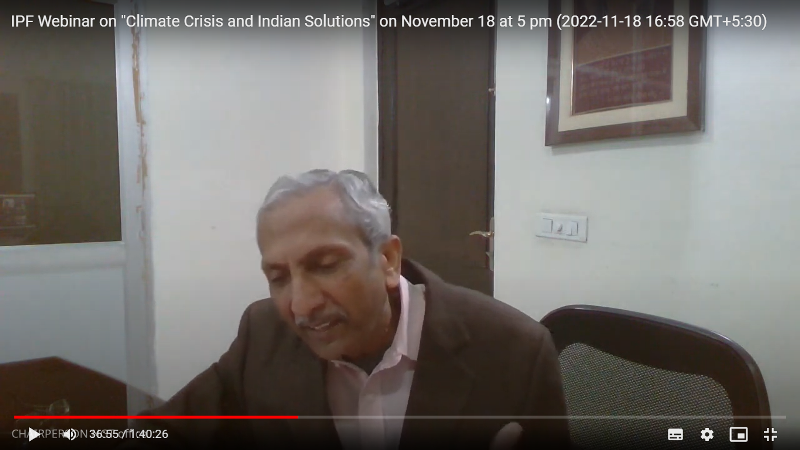
Dhanpat Agarwal: Please give some comments on CoP 27 about mitigation and adaptation.
Justice Goel: The so-called developed countries have yet again put impractical conditions for climate finance and the so-called developing countries will find it difficult to bring about any major changes in their situation without climate finance. There will be more such conferences and the only thing I can say is, let us hope for the best.
Priyadarshi Datta: Can NGT admit any suit against government policy of scrapping cars if some litigant takes it to the Tribunal?
Justice Goel: It is possible if the petition is backed by scientific evidence, then we have the power to examine it. But if there are two views possible on a matter, the government’s views will prevail. NGT has the power to intervene only if there is a clear violation of existing laws or if the view is completely irrational.
Narendrakumar Jain: Your lordship has given many orders in which profits from environment violation is to be treated as an offence under PMLA. Please elaborate on its maintainability.
Justice Goel: There is clause in PMLA itself that if you derive any profit from any activity which violates any particular act, then it is an offence under PMLA.
Narendrakumar Jain: Your lordship has given many orders in which in spite of the industry having applied for groundwater NoC on time and the regulator or statutory body has not acted upon, the industry is said to be in violation. While this could be applicable to new industry, does this not cause injustice to an operating industry that has been existing for decades?
Justice Goel: In the Supreme Court judgement, it was stated that it was to be first determined if the ground water can be replenishable or not. A meter has to be installed to determine the usage of ground water. If there has been no study conducted, meter installed or if a dark zone had already been notified indicating that ground water cannot be replenished or it is a critical zone, then simply giving an application cannot be excused. Mere filing of application doesn’t comply with regulation. Be it new or old industry, if there is no groundwater and you still keep pumping, then consequences are disastrous. In terms of money and costs to the atmosphere, it will be very high as it will add to the salinity of the groundwater and it obstructs the flow of the rivers. This will come at a huge cost to society. So, we have to strike a balance between the individual’s needs and society’s needs.
Sanjiv Kumar: Delhi is the most polluted city. Number of small-scale industries and fuel used in industries needs a detailed study. The data available in the Pollution Control Board is not updated, both for Delhi and NCR.
Justice Goel: The data has been collected. With every judgement of the Supreme Court on this issue, activities are resumed but it stops after a while. It becomes difficult for populist governments to monitor this considering the immediate needs of the population. The local administration also doesn’t disturb such activities. The long-term consequences take a backseat in light of ensuring that people have livelihoods and the economic development takes place. These are difficult issues and I wouldn’t be equipped to comment on it as in my role, I am only looking at the legal aspect.
Devesh Khandelwal: Today, these huge expressways are being built and for this, thousands of trees are cut down. As a solution to this, it is stipulated that an equal number of trees should be planted elsewhere. But it would take at least 20 years for the ecosystem to develop in this new area. What is NGT’s take on this?
Justice Goel: You are absolutely right. Even cutting one tree is equal to the death of a human being and maybe so many human beings as a tree sustains so many lives. On the contrary, one human being generates so much of carbon dioxide. At the same time, development is also necessary. Highways are society’s needs and so is environment. Cutting one tree and planting a tree elsewhere is no compensation. I fully agree with you. Rules specify that plantation should be there on both sides of a highway but now we see buildings coming up on both sides which is an issue of compliance. Steps are being taken to ensure that rules are followed. But this is a complex issue.
Shivaji Sarkar: As far as cutting of trees for highways is concerned, there is a whole mafia involved and profiting out of it. It may not be possible for any body to put an end to this.
Justice Goel: This is a social and administrative issue. It has come to our notice that there are many issues with the administration and not everyone is doing their duties. Mafias are everywhere. There is even a garbage mafia that don’t let people clear the dumping grounds. Then there are sand mafia, coal mafia etc. If we are able to control the mafias, then we will be able to reduce the pollution to some extent. But this is not easy. If you recall, the officers who have tried to stop mining are killed by these mafias. They are so powerful that it is not easy to stop them. To some extent, there is also a nexus between these criminals and politicians and there are so many cases pending in courts related to this.
Dr Ratnoo: Since you mentioned, sand mining, I come from Rajasthan and there was a ban on fine gravel mining for a long time. The gravel mining mafia has been strong in this region and they have continued mining. This has also turned into an opportunity for officers at the district and block level to make a good amount of money. The mafia has been threatening anybody who has been raising their voices against them. As you said, there is also the political nexus. But the problem with the ban is, it also completely halts construction activities. People are no longer able to make homes, schools, hospitals and other necessary buildings. Do we have any alternative to ensure that the construction activities do not stop?
Justice Goel: It is true that we need to find solutions. If there is an opportunity to profit, people will misuse it. Take the case of plastics for example. They feel using plastics is cheap and convenient. My point is we should limit the construction activities to what is really needed. Otherwise, we keep occupying agricultural land and construction activity itself is polluting. So, we need to limit construction activities. Coming to solutions, if we follow the scientific approach to mining, then profit will be less. So, government should undertake this process directly and should stop issuing tenders to contractors. Here, another question that can arise is if government machinery can be fully trusted. Ultimately, the social, political and lifestyle issues are all interconnected. The solution to this cannot be isolated. It has to be comprehensive by bringing together all the stakeholders.
Dr Ratnoo: We should research on what materials were used in the earlier times and bring them back.
Justice Goel: It is important to do so. We will have to go back to the old times and bring back the old practices. We have to put an end to our consumerism. There can be modern thinking. We can modernise our homes but we also need to think about the money that is being invested in buildings that people never live in. There are so many unfinished projects. So, it is important to conduct awareness on the distribution of wealth, use of wealth and approach towards money and approach towards materialism.
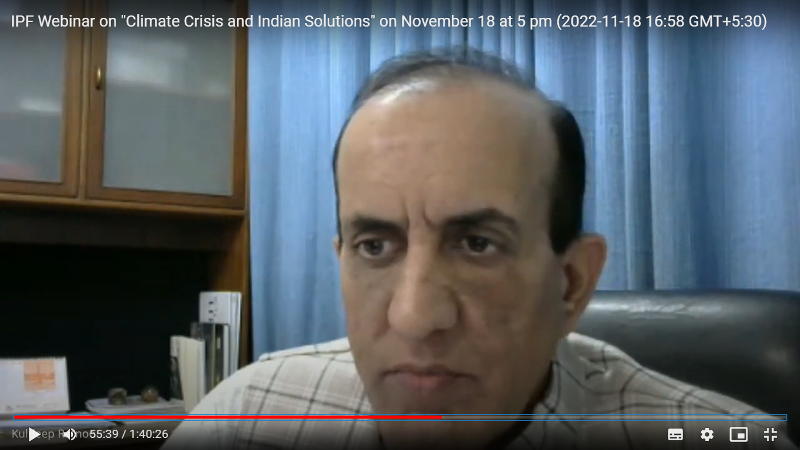
Dr Ratnoo: Sir, you have raised a very valid point. For those buyers who really need homes, the costs keep rising. We have turned real-estate into a source of investment. Those who have surplus money or black money invest in properties because of which many towers have come up which are infested by just pigeons. No human being lives in those buildings. It is unfortunate. It is a vicious cycle in modern economy in which for economic development, one has to come to towns from villages and from there move on to cities, and then to metros. We are all seeing how the cities and towns are getting burdened. So, it is important to take employment opportunities to villages. Take the case of Bengaluru for example. There was a time when it was called the garden city and was known for its pleasant weather. Now the place is getting warmer, pollution levels are rising and in the recent floods, many citizens were affected. All the funds are getting allocated to metro cities which are being used to build metros, beatification of the cities etc. There is no creation of employment opportunities where it is needed. In this situation, NGT has a significant role to play. We as citizens should also play an equally important role in spreading awareness in society.
Thank you, sir, for giving us your valuable time. I would also like to thank all the participants who patiently listened, asked questions and made it in an interactive session. We have all got to learn a lot from today’s webinar and have been enlightened on so many topics. I thank everyone on behalf of India Policy Foundation.

